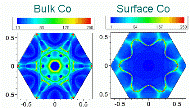Department of Physics and Astronomy: Publications and Other Research
Date of this Version
2-7-2005
Abstract
Feshbach-Fano resonance theory (FFRT) is used to determine the energy dependence of the complex energy shift function, consisting of the real energy shift and the resonance width, and the background phase shift for several simulated molecular shape resonances. Attention is paid to the way the choice of the quasibound state (QBS) function required in the FFRT affects these energy dependencies. An overlap criterion for choosing an optimal QBS function is proposed. Using our treatment on t-butylchloride, carbon tetrachloride, ethylene, and benzene, we give numerical results for specific cases of l = 1 through 4. We find that the real energy shift function does not vary greatly over the width of the resonance, although the magnitude of the shift can be fairly large. We also find that the behavior of the background phase shift due to orthogonality scattering is sensitive to the presence of long-range potentials.


Comments
Published by American Physical Society. Phys. Rev. A 71 022710 (2005). http://pra.aps.org. Copyright © 2005 American Physical Society. Permission to use.